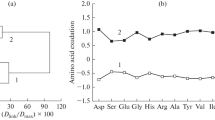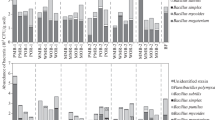Summary
The mulberry leaves were shown to harbour substantial populations of bacteria, streptomycetes, yeasts, and moulds. Azotobacter and Beijerinckia were observed to contribute to nearly 5 to 10 per cent of the bacterial population. When grown in water culture under sterile conditions, Azotobacter inoculation on the leaf or root surface was found to increase plant growth, dry wt, and nitrogen content of the mulberry. The beneficial effect of Azotobacter was largely influenced by the presence of a carbon source in the plant nutrient solution. The root inoculation in comparison to leaf application was found to confer greater benefits to the growing plant. The presence of carbohydrates and amino acids in the leaf leachates of mulberry was shown. The mutual beneficial nature of the association of the plant and Azotobacter has been brought to light.
Similar content being viewed by others
References
Agnihothrudu, V., Aspergilli from the soils of South India. Naturwiss.44 65 (1957).
Attiwill, P. M., The chemical composition of rain water in relations to cycling of nutrients in mature eucalyptus. Plant and Soil24 390–406 (1966).
Becking, J. H., Studies on the nitrogen fixing genus Beijerinckia I. Geographical and ecological distribution in soils. Plant and Soil14 49–81 (1961).
Gebgardt, A. G. and Kovalschuk, S. I., The effect ofAzotobacter on the content of vitamins in soil and oat germs. Mikrobiologiya27 331 (1958).
Hoagland, R., and Arnon, D. I., The water culture method of growing plants without soil. Univ. California Exp. Sta. Circ.347 (1938).
Kuster, E., Selection of media for isolation of Streptomycetes Nature202 928 (1964).
Long, W. G., Street, D. V., and Tukey, H. B., Loss of nutrients from plant foliage by leaching as indicated by radio isotopes. Science123 1029 (1956).
Moroney, M. J., Facts from Figures, p. 396. Penguin Book Co., London (1951).
Rosen, H., A modified ninhydrin colorimetric analysis for amino acids. Arch. Biochem. Biophys.67 10–15 (1957).
Rovira, A. D., Microbial inoculation of plants I. Establishment of free living nitrogen fixing organisms in the rhizosphere. Plant and Soil19, 304–314 (1963).
Rovira, A. D., Interaction between plant roots and soil microorganisms Ann. Rev. Microbiol.19, 241–266 (1965).
Ruinen, J., Occurrence of Beijerinckia in the ‘phyllosphere’. Nature177, 220 (1956).
Ruinen, J., The Phyllosphere I. An ecologically neglected milieu. Plant and Soil15, 81–109 (1961).
Ruinen, J., The phyllosphere. III. Nitrogen fixation in the phyllosphere. Plant and Soil22, 375–394 (1965).
Tukey, H. B. Jr., Wittwer, H. R., and Tukey, H. B., Leaching of carbohydrates from plant foliage as related to light intensity. Science126, 120 (1957).
Umbreit, W. W., Burris, R. H., and Stauffer, J. F., Manometric Techniques, p. 238. Burgess Publishing Co. N.Y. (1957).
Vancura, V., Detection of Gibberellic acid in Azotobacter cultures. Nature192, 88 (1961).
Vancura, V. and Macura, J., Indole derivatives in Azotobacter cultures. Fol. Microbiol.5, 293 (1960).
Vasantharajan, V. N., and Bhat, J. V. Interrelations between soil micro-organisms and mulberry. I. Phytohormone production by soil and rhizosphere bacteria and their effect on plant growth. Plant and Soil27, 261 (1967).
Yemm, E. W. and Willis, E. J., The estimation of carbohydrates in plant extracts with anthrone. Biochem. J.57, 508 (1954).
Author information
Authors and Affiliations
Rights and permissions
About this article
Cite this article
Vasantharajan, V.N., Bhat, J.V. Interrelations of micro-organisms and mulberry. Plant Soil 28, 258–267 (1968). https://doi.org/10.1007/BF01880243
Received:
Issue Date:
DOI: https://doi.org/10.1007/BF01880243




